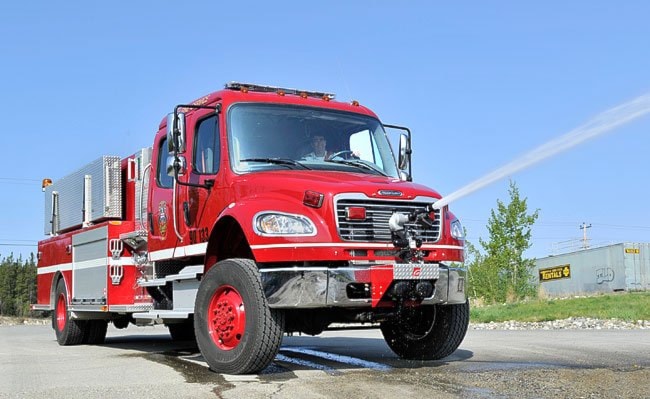Sometimes you have to trust the professionals to come up with the right words.
Kurt Vonnegut said, “I can think of no more stirring symbol of man’s humanity to man than a fire engine.”
“I think that if Kurt Vonnegut can say it, I can,” laughs Yukon’s fire marshal, Dennis Berry.
Trucks used in communities across the territory are more than symbolic. They’re designed to fight fires and protect the men and women who put their bodies on the line to work.
As tools improve to fight fires, so do the trucks.
In recent years the fire marshal’s fleet of 68 trucks covering fire departments in Yukon communities has been getting a bit of a facelift.
The latest community to get a shiny new truck is Tagish.
The new Tagish truck is capable of fighting a fire, but its main job is to carry water. In areas without fire hydrants nearby, the truck needs to carry lots of it.
The tanker can hold about 1,400 gallons, dump that into a portable pool at a fire scene, and head back to get more.
There are some obvious differences between this tanker and the one that came before it.
First, it’s bigger. That’s in part because of the new all-wheel drive capability and in part because it can now carry more people - five firefighters instead of two.
“Now we’re delivering not just water, but actual firefighters to the scene,” Berry said.
Those firefighters also come with all their equipment. Seats in the new truck have cutouts in the back so firefighters can sit inside with their equipment on and speed up their response time when they get to a fire.
Unlike the old version, which could just transport water, this truck also has hoses attached and can be used to fight a fire.
In total, there are about 225 volunteer firefighters in the Yukon. Berry says the truck itself is more user-friendly, with fewer complicated steps to get things done.
“The reason it’s an improvement for us is that it’s just allowing us to do more with fewer people. The jobs that are critical are getting done quicker,” he said.
Berry credits the Yukon government with pledging to improve the Yukon’s fire trucks.
The Tagish truck is the fourth upgraded vehicle purchased in the last few years. Its price tag was about $300,000.
The plan right now is to buy two new trucks a year for the foreseeable future, he said.
Every time a new truck is purchased the territory does a fire truck shuffle - moving trucks to the busiest communities around the territory and taking the oldest versions out of daily service.
“By the time we get done the first, we’ll be back to the last probably,” Berry said. “We do get a lot of value out of our trucks. We repurpose them many times over.”
Fire trucks are not one-size-fits-all, and northern trucks have requirements that you’re not going to find in most places in southern Canada.
Each truck in the Yukon has one vital difference from its southern counterparts: a heater protects the equipment.
Berry calls a frozen water line at a fire scene his “worse nightmare.”
“If we take a hand line out of the truck and put it out three lengths at minus 40, if we don’t leave that hand line running just a little bit, in about a minute and half it’ll freeze solid. Then it’s just useless to us.”
Some of the new bells and whistles on the Tagish truck are less obvious than others. When Berry starts pressing buttons, lights fold up from the top that can illuminate an area the size of a football field and can be seen from at least three kilometres away.
In the Yukon, where some seasons can see a lot of darkness, lighting a scene used to take time and resources, Berry said.
“In the old days what we’d do is pull off a generator, pull off portable lighting, string out electrical cables. Three people would have to do that.”
The truck also has a giant subwoofer.
Know as the rumbler, it’s connected to the standard lights and sirens so that drivers can feel a fire truck coming by even if they don’t see it.
“You’d be surprised at the number of people who don’t pull over for emergency vehicles, who don’t slow down for emergency scenes,” Berry said.
“As first responders we need people to slow down, really slow down and take caution as they go past a scene.”
While it might at one time have been unheard of to blow past a fire truck, Berry said he’s seeing that more often now.
“I think in large part it’s a community attitude.”
Add that to modern distractions in cars, and people just aren’t paying attention, he said.
“Now they wouldn’t hear lights and sirens, because we’re in a cocoon, our little cocoon.”
On the front of the new truck sits what is essentially a giant water cannon.
Using a joystick from inside the cab, Berry can direct a stream of water at pressures up to 200 pounds per square inch.
“You could blow out windows if you wanted to,” he said.
The water pressure coming out of the front is connected to the truck’s throttle. Berry, or any trained firefighter, can set it up to spray water directly, in a mist-pattern, or to oscillate like the world’s biggest lawn sprinkler.
“So you can pull up, you can initiate (fire) suppression and they don’t even have to get out of the truck,” he said.
Berry compares getting new fire trucks to upgrading any other piece of work equipment, from a photocopier to a computer, to make a job faster, easier and more efficient.
“It’s all about making it easy for the firefighters to do their job. That’s the big thing this truck does.”
Contact Ashley Joannou at
ashleyj@yukon-news.com
